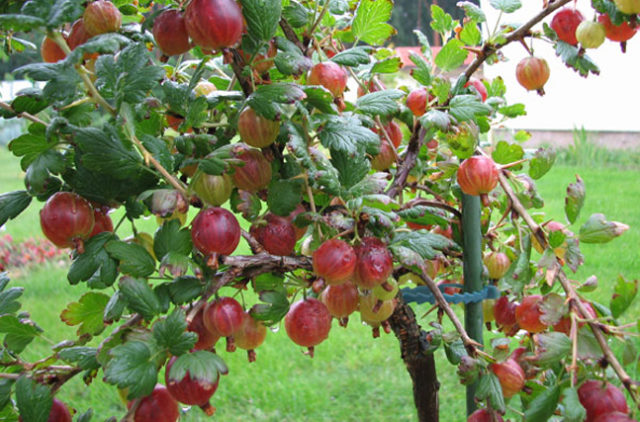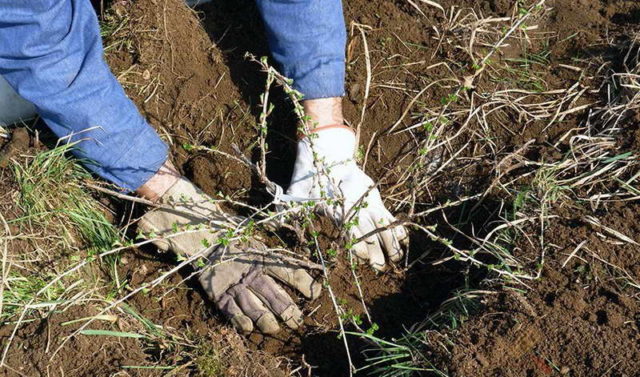Content
Gooseberry is a common crop. A variety of varieties allows you to choose a specimen suitable for planting with certain characteristics. Gooseberry Shershnevsky is a medium late variety, characterized by good yield and dessert fruit taste.
Description of the gooseberry variety Shershnevsky
The Shershnevsky variety is included in the State Register in 2016, the gooseberry is recommended for cultivation in four regions: Ural, West and East Siberian, Middle Volga.
The Shershnevsky variety grows sprawling. Shoots form straight, multi-colored: 2/3 of the length of the green tint, the top is purple.
Shershnevsky gooseberry studs are average. The thorns of this variety are elongated, medium in thickness, sharp. Usually there are singles, but there may be doubles. Thorns are formed perpendicular to the branches, there are no thorns in the upper part of the shoot. The color of the thorns ranges from light beige to brown.
Shershnevsky gooseberry shoots are covered with dark green foliage. The size of the leaf plate is average, without pubescence, the surface is soft to the touch, with small wrinkles, and it looks shiny. There is a deep recess at the base of the sheet plate. Short teeth are formed along the edges of the foliage, which do not bend inward. The leaf is divided into 5 lobes with deep cuts, attached to a slightly pubescent green petiole of medium thickness and length.
The buds of the Shershnevsky gooseberry are round with a pointed top, small. They are formed singly, have a light brown color.
The flowers are medium in size, combined in two-flowered inflorescences. The shade of sepals is pink. Pedicels are shortened, green in color, without pubescence.
Berries of the Shershnevsky variety have a rounded shape that resembles an oval. There is no pubescence on them. The color of ripe berries is dark pink, a matte bloom is visible from above. The skin can be medium or thick. The size of the berries is from medium to large, weight is 3-5 g, the indicator depends on the growing conditions and the number of ovaries.
The yield of the Shershnevsky gooseberry is higher in the presence of pollinating varieties. Without cross-pollination, the yield will be very low. Bees increase the index, but insects do not fly in cold and rainy weather, which leads to low fruit setting.
Drought resistance, frost resistance
Gooseberry variety Shershnevsky tolerates drought well, does not require frequent watering.
The frost resistance index of the Shershnevsky variety is average, without shelter it tolerates frosts down to -20 ° C. In regions with little snow, the root system may freeze, so preparation for winter is required.
Fruiting, productivity
The yield indicator of the Shershnevsky variety does not exceed 3-3.5 kg from each bush.
Shershnevsky gooseberry is a medium-late ripening variety. The berries ripen in the first half of August, but they are able to hold out on the bushes without shedding and loss of taste until September. Berries are not prone to baking. Due to their dense skin, the berries tolerate transportation well and are stored for a long time in cool conditions.
Gooseberry berries contain vitamins and nutrients, therefore they are used in the food industry, as an additive for diseases of the heart and blood vessels, in cosmetology.Gooseberry pulp mask relieves dryness and brightens the skin of the face.
Jams, jams, compotes are made from this variety of gooseberries. The fruits have a diuretic, choleretic and laxative effect, can be used as a general tonic product.
Advantages and disadvantages
The Shershnevsky gooseberry variety has both positive and negative qualities.
The advantages of the variety include:
- dessert taste of fruits;
- good frost resistance;
- the possibility of transportation and storage;
- average yield;
- resistance to foliar diseases;
- slight studding.
The disadvantages of the gooseberry Shershnevsky include:
- the need for pollinating varieties;
- the possibility of freezing of the roots in the absence of snow in winter.
Breeding features
If the gooseberry variety fully meets the needs of the owners, it becomes necessary to propagate the culture. In order not to buy seedlings from the nursery, you can perform the procedure using one of the methods described below:
- seeds;
- dividing the roots of the mother plant;
- cuttings;
- layering;
- vaccination.
Breeding gooseberries with seeds takes a very long time, and you can get a bush that does not correspond to the characteristics of the parent plant.
When dividing the mother bush, there is always a risk of damage to the roots, so you need to act carefully. This method is used in the event that it is necessary to transplant an adult bush from one area to another, while it can not only be transplanted, but also divided into several copies. A year before transplanting, old shoots are cut off on the plant, this will make it possible to form new branches. Next year, the bush is dug up, the root is divided into 2-3 parts and immediately planted in new holes. A suitable period for transplanting is spring or autumn; this method is not used in hot weather.
Lignified gooseberry cuttings root poorly (2-3 pieces out of 10), so this method is considered ineffective. They are harvested in the fall, the length should be about 20 cm, then planted at an angle of 45 ° on a garden bed or in a container with fertile soil. A distance of 15 cm is maintained between the cuttings. The earth is compacted and mulched with peat, and covered with insulation for the winter.
They are harvested in June and planted in containers with a fertile substrate at a distance of 7-10 cm from each other.
The method of vertical or horizontal layering is considered the most effective when propagating gooseberries. With the horizontal method, the old shoots are bent to the ground, fixed with hairpins and covered with earth. After rooting, the layers are transplanted to a new place.
The method of vertical layering consists in filling the bush with moist soil to a height of 10-15 cm. The procedure is carried out in the spring, then the bush is periodically spud. If everything went well, in the fall, the formed young bushes are separated from the adult plant.
Planting and leaving
Shershnevsky gooseberry seedlings can be planted in spring or autumn, but the autumn procedure is considered more effective. In spring, the planting period is delimited by swelling of the buds and thawing of the soil, so it can be difficult to do this in a timely manner.
The yield of the Shershnevsky gooseberry variety depends on the correct choice of the planting site. The better the illumination on the site, the higher the indicator. Small berries form in the shaded area, so the yield drops sharply.
It is better to purchase a seedling in specialized nurseries with a closed root system. If the gooseberry is bought with open roots, then they are examined and dried and damaged roots are removed.
Be sure to observe the interval between seedlings - 1-1.5 m. The planting hole is dug in accordance with the size of the root system. You can plant in a trench 0.5 m deep, this method is suitable for seedlings that are 1-2 years old.
A nutrient mixture is introduced into the pit for planting gooseberries, consisting of the following components:
- humus - 1 bucket;
- wood ash - 1 glass;
- double superphosphate - 50 g;
- potassium sulphide - 30 g.
The seedling is placed in a pit with a slight slope. The soil is covered and lightly tamped, then the bush is watered.
Growing rules
Adult gooseberry bushes are watered several times per season. If the weather is hot, the first watering is carried out in late May - early June, then the soil is moistened during the ripening of the berries, in the autumn period (September-October), water-charging watering is carried out. Young seedlings are watered more often (2-3 times a month).
After watering, the soil is loosened and mulched, this procedure helps to retain moisture and prevents weeds from growing. Peat, compost, freshly cut grass, straw are used as mulch.
Pruning Shershnevsky gooseberries is necessary for the correct formation of the bush. In the spring, pruning is carried out before the start of sap flow, but if the moment is missed, it is better to postpone the procedure until autumn. Remove damaged, old branches and weak growth. After pruning, branches of different ages should remain on the bush.
Bushes can be grown on a trellis, cutting and tying branches in a timely manner. This method is convenient for harvesting.
After planting, the gooseberries are fed three times per season with saltpeter, 50 g of the substance are added to each bush. The first feeding is carried out after the length of the shoots is 5-6 cm, then during flowering and fruiting. The interval between dressings is 2-3 weeks.
For feeding, you can use mulching with humus, rotted manure or compost.
To protect the bushes from rodents, chemicals are laid out on the site or the gooseberries are covered with spruce branches.
Preparing gooseberries for winter is required in regions with cold or little snowy weather. The shrub is well watered, the trunk circle is mulched, and covered with spruce branches from above. Gooseberry branches can be bent to the ground and wrapped with insulating material, sprinkled with snow in winter.
Pests and diseases
The following insects are dangerous for the Shershnevsky gooseberry variety:
- gall and gooseberry aphids;
- moth;
- sawfly;
- moth.
To combat insects, spraying the crown (Fitoverm, Lipidotsid), digging the trunk circle, shaking off the caterpillars is used.
Gooseberries of the Shershnevsky variety can suffer from such diseases:
- spheroteka (powdery mildew). For the fight, treatment is used with an 8% solution of ammonium nitrate, 1% copper sulfate;
- anthracnose. To eliminate the pathology, pruning and destruction of damaged shoots, treatment with iron vitriol (3%) is necessary;
- white spot (septoria). Treatment with copper or iron sulfate is required.
Conclusion
Gooseberry Shershnevsky is a variety characterized by a high yield and dessert taste of the fruit. Used for cultivation in private farmsteads, can be grown commercially.











